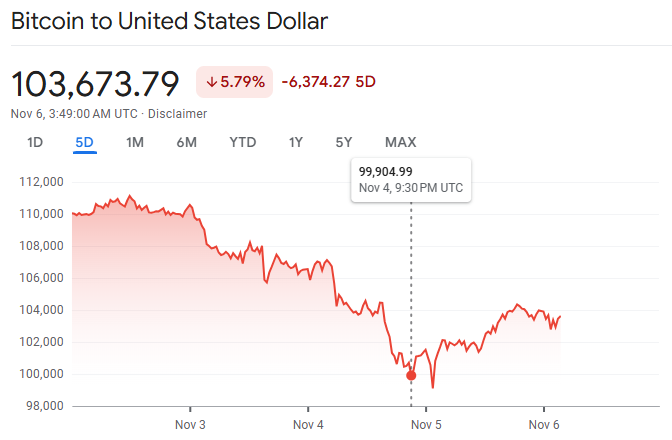Key Takeaways
On November 4-5, 2025, Bitcoin briefly dipped below $100,000 following a 20% decline from its peak of $126,000.
Analysts note that this pullback primarily reflects profit-taking and the unwinding of leverage, rather than signalling the start of a new bear market.
Critical support levels remain near $95,000 to $100,000, with $80,000 viewed as a deeper correction target if those supports fail.
ETF inflows and macro sentiment will determine if Bitcoin stabilises or tests new lows in the coming weeks.
Bitcoin, the pioneer cryptocurrency, has experienced significant price volatility throughout 2025, recently slipping below the psychologically crucial $100,000 mark on November 4-5 after a steady rally earlier in the year.
As the market digests recent corrections amid macroeconomic uncertainty and shifting investor sentiment, many ask: Will Bitcoin drop below $100,000 again?
This article examines the latest price action, underlying drivers, potential scenarios, and key factors for investors to watch in the coming months.
Bitcoin Dropped Below $100,000 for Seconds on November 4-5

As mentioned above, Bitcoin plunged below the $100,000 mark during the correction that began in early November, losing more than 20% from the October record highs above $126,000.
This decline triggered broad selloffs across the crypto sector, with most altcoins likewise down significantly. However, Bitcoin rebounded quickly, trading back above $103,000 amid signs of renewed buying interest.
Traders and analysts are divided, with some seeing the action as a typical deleveraging/profit-taking adjustment that removes surplus leverage.
On the other hand, option and futures order flow suggest that participants are hedging against the possibility of a deeper drop (options flow suggests some market participants are hedging against scenarios that would take Bitcoin toward the $80k–$90k area).
Why Did Bitcoin Fall Below $100K?
1. Overheated Valuations and Profit-Taking
Following an extraordinary run in 2025, with Bitcoin rising from above US$90,000 to US$95,000 in April to over US$125,000 in October, some investors chose to lock in their profits by selling their gains.
Analysts warn valuations, especially in the rapidly growing AI and blockchain sectors, may have become stretched, prompting a natural pullback.
2. Macro and Monetary Policy Influences
Concerns about interest rate policy uncertainty, particularly in the U.S., created a risk-off sentiment, reducing speculative appetite for volatile assets, such as cryptocurrencies.
The ongoing U.S. government shutdown and geopolitical tensions further dampened sentiment and investment flows.
3. Regulatory and Institutional Factors
What Is Bitcoin's Price Telling Us Now?

1. Price Context
Bitcoin reached new all-time highs exceeding $126K in early October 2025, before dropping back in November and momentarily falling below $100K during the correction.
That decline signals a cycle reset, not necessarily the end of the uptrend.
2. Volatility & Liquidation Events
Multiple reports indicate heavy liquidations of leveraged long positions on major exchanges during the initial leg down; exchanges' futures and margin systems forced stop-outs, which fed additional selling and pushed spot lower.
This deleveraging pattern often causes sharper but shorter-lived corrections.
3. Derivatives Positioning
Options markets suggest traders acquiring downside protection, with a shift in skew toward puts. The options layout suggests that advanced participants are factoring in a significant likelihood of a deeper drop to $80K–$90, while others anticipate consolidation.
This asymmetric hedging often precedes periods of elevated short-term uncertainty.
4. Institutional Flows
Spot Bitcoin ETFs saw a slowdown in inflows during the correction. While long-term institutional demand remains strong, the pause removed a short-term support layer that previously helped maintain price momentum. [1]
Is Another Bitcoin Drop Below $100K Likely? (Technical View)
Technical analysis is not destiny, but it helps frame probabilities.
| Level |
Description |
Market View (Nov 2025) |
| $125K–$126K |
Previous all-time high |
Major resistance |
| $110K–$105K |
Short-term recovery zone |
Needs reclaim for bullish reversal |
| $100K–$95K |
Key support cluster |
Crucial defense area |
| $85K–$80K |
High-volume zone |
Deep correction target |
1) Key Immediate Support:
$95K–$100K was an important area of accumulation in prior months; breakdown through $100K opened room for a move toward the next structural support near $80K–$85K (an area flagged by options hedging and prior volume clusters).
2) Resistance to Reclaim:
$105K–$110K and then $118K–$125K are the key levels to clear for bulls to regain control.
A weekly close back above $110K would materially improve the odds of a sustained rebound.
3) Momentum & Moving Averages:
Short-term momentum indicators flashed oversold in the immediate aftermath of the drop, which historically can lead to snapbacks, but medium-term averages (50–200 MA) will matter if the correction persists.
Macro & Cross-Asset Drivers to Watch
1. Equity and Tech Selloff:
Bitcoin's correlation with global tech stocks tightened in 2025.
Weakness in mega-cap tech shares reduced risk appetite, spilling into digital assets.[2]
2. Rate Expectations and Liquidity:
Changes in real yields and liquidity outlook drive crypto capital flows.
If central banks pause or pivot toward easing, Bitcoin may recover swiftly as risk appetite returns.
3. ETF & Institutional Demand Churn:
Although institutional adoption through ETFs created a structural demand during the rally, the impact of marginal buyers can diminish rapidly during risk-off periods, leaving the spot vulnerable.
ETF inflows and broader macro sentiment will be important determinants of whether Bitcoin stabilises or tests lower support levels in the coming weeks.
Three Scenarios for Bitcoin's Near-Term Path

Scenario 1: Shallow Recovery & Consolidation (Base Case, ~45% Probability)
Bitcoin holds a range between $95K and $118K for several weeks as leverage clears, miners pace selling, and ETF flows stabilise.
Volatility subsides, the options skew normalises, and buyers re-enter near the mid-point.
Indicators that favour this include falling liquidation volumes, stabilising exchange balances, and resumed, but moderate, ETF inflows.
Scenario 2: Deeper Correction Toward $80K (Tail but Plausible, ~30% Probability)
Negative macro surprises or continued tech risk-off cause foreign liquidity to dry up; option markets and futures suggest protective positioning for $80K scenarios; miners and whales accelerate selling into weakness.
Signposts: sustained increase in put buying, failing to reclaim $105K within a week, and renewed surge in exchange inflows.
Scenario 3: Quick V-Shaped Rebound Above $120K (Optimistic, ~25% Probability)
A capitulation phase occurs rapidly when buyers, including institutions and spot ETF inflows, step in, and short-covering sparks a sharp rebound.
Key triggers include strong macro liquidity news, resumption of ETF buying, and a swift decline in open interest, signalling that deleveraging is complete.
While this turnaround can happen quickly, it requires unmistakable risk-on signals to sustain momentum.
Key Levels Traders Should Watch
Short-Term Trading:
Watch $95K–$102K as the immediate battle zone. Failure to maintain support above $95,000 could open the way for a decline towards key support zones in the $80,000 to $85,000 range.
Successful reclaim of $110K within several sessions shifts momentum to the bulls.
Swing Investor:
Use dollar-cost averaging (DCA) in tranches if you believe in long-term adoption. A disciplined buy plan (e.g., 20% tranches on technical milestones) reduces timing risk.
Long-Term Trader (HODL):
Focus on conviction factors (adoption metrics, ETF flows, regulation landscape) rather than daily price noise.
Significant declines can be distressing, yet they have historically represented purchasing chances for patient investors.
Frequently Asked Questions
Q1: Has Bitcoin Fallen Below $100K Permanently?
No. The November 2025 dip below $100,000 proved to be temporary, with Bitcoin quickly rebounding to trade back above the $103,000 level shortly thereafter.
Q2: Will Bitcoin Definitely Drop Back Under $100K?
Not necessarily. It already dropped below $100K briefly; whether it does so again depends on derivatives positioning, ETF flows, miner behaviour and macro risk appetite.
Q3: Is $80K a Realistic Target?
Yes. $80K appears in some derivatives, hedges, and technical volume-support maps
Conclusion
In conclusion, Bitcoin's quick drop below $100,000 in November 2025 represents a classic market correction after unprecedented gains.
While short-term volatility may persist, the broader trend remains supported by increasing adoption, ETF participation, and the underlying scarcity mechanism of Bitcoin itself.
Investors should remain data-driven by monitoring key price zones, liquidity trends, and macro developments, rather than reacting to short-term noise.
Disclaimer: This material is for general information purposes only and is not intended as (and should not be considered to be) financial, investment or other advice on which reliance should be placed. No opinion given in the material constitutes a recommendation by EBC or the author that any particular investment, security, transaction or investment strategy is suitable for any specific person.
Sources
[1] https://www.businessinsider.com/bitcoin-price-bear-market-outlook-crypto-btc-liquidation-2025-11
[2] https://www.theguardian.com/business/live/2025/nov/05/china-ends-tariffs-us-imports-soy-bean-levies-ms-profits-cyber-attack-business-live





























